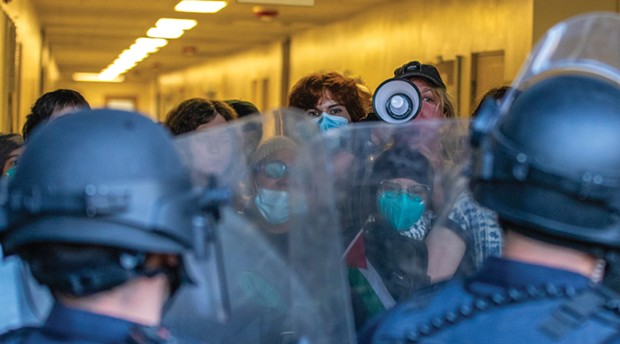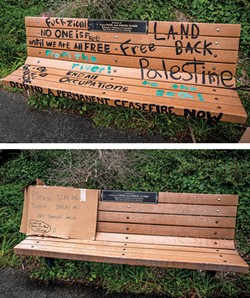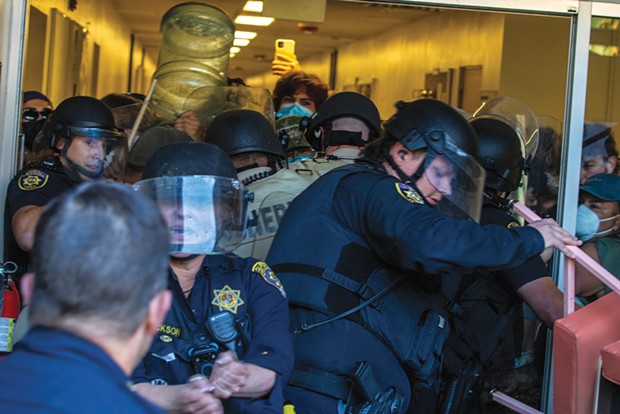'False Narratives'
Tom Jackson Jr.'s chief of staff offers defiant defense of university's handling of protests
By Thadeus Greenson [email protected] @ThadeusGreenson[
{
"name": "Top Stories Video Pair",
"insertPoint": "7",
"component": "17087298",
"parentWrapperClass": "fdn-ads-inline-content-block",
"requiredCountToDisplay": "1"
}
]
It's a sunny, cloudless afternoon the day before commencement and Mark Johnson is sitting in a nondescript conference room, its windows shuttered, talking to the North Coast Journal in the Student and Business Services Building at Cal Poly Humboldt. The campus remains quiet and largely vacant two weeks into a "hard closure" instituted in response to student protesters' occupation of Siemens Hall. Johnson, the chief of staff to university President Tom Jackson Jr., offered up the interview after the Journal emailed the university's marketing and communications department a couple days earlier with some follow-up questions about Johnson's statements earlier in the week that Jackson chose not to attend a University Senate meeting due to "legitimate concerns about his personal safety."
The Journal's email asked whether Jackson had received threats and, if so, what they entailed and, if not, the source of his concern. The Journal also asked whether Jackson planned to attend commencement ceremonies.
Johnson, it turns out, wants to talk about much more, taking the opportunity to address what he sees as "some false narratives" about the campus protest and the way the university handled them, which had drawn national press coverage. But first, he starts by asking the Journal whether it had witnessed his treatment at the University Senate meeting, which saw one attendee angrily confront Johnson with a photo on her phone of a student injured in a clash with police the evening the occupation began, a group of students chant a polite request that he resign as he left the meeting and numerous speakers cast the university's administration as uncaring or indifferent.
"It's shocking and painful to hear that when our first priority throughout this has been the safety of everyone on campus," he says. "You saw the things I had to deal with."
He then turns to the Journal's questions about Jackson.
"He has received some very specific, very racist threats toward him and his family," Johnson says, declining to offer specifics out of respect for Jackson's family but adding that the University Police Department recommended he not attend the meeting, noting that sending him with "an officer as protection" would have been "incendiary."
Johnson adds that campus staff and administrators have also been threatened. Asked to clarify, he says maintenance workers were followed, surrounded and intimidated during the protests, adding, "It was just thuggery." He says several administrators received anonymous letters at their home addresses, which they found threatening, providing the Journal a copy of one, which accuses its recipient of "protofascist behavior" and "radical incompetence."
"You have done enormous harm to this university and this community, and your complicity in this disaster has been widely noted by your neighbors," the letter concludes.
As to Jackson, Johnson says he "is here on campus every day," but would not be attending commencement, saying Jackson's daughter was graduating the same day and he'd planned to attend that ceremony long before the occupation of Siemens Hall.
Johnson, a retired Navy captain who'd spent two years leading the "supply chain team" at MOD Pizza before the university hired him in July to be the primary liaison between the president's office and the campus, then turns to the "false narratives."
From the moment video began circulating of a violent scrum between protesters trying to hold their space in Siemens Hall and police in riot gear trying to force their way into the building during the protest's first hours on April 22, Cal Poly Humboldt's administrators have faced sharp criticism for their handling of the situation. Within days, the school's general faculty had overwhelmingly passed a no-confidence vote in Jackson and Johnson, and the University Senate followed suit, while a letter calling for the two men's resignations drew signatures from more than 300 faculty and staff members. The continued "hard closure" of campus, which threatened students, faculty and staff with arrest or citation for unauthorized visits to campus, and the decision to use hundreds of out-of-area police officers to clear the campus before dawn on April 30 have only seemed to further enflame the situation.
Sitting in the conference room, Johnson says administrators did all they could and he makes no apology for any of the decisions made. First, he takes on the notion that "somehow the university is anti-free speech."
Free speech, he says, is "fundamental to our core purpose" and protected by the campus' time, place and manner policy, which details in a "content neutral" manner how protests, assemblies and demonstrations are allowable so long as they aren't disruptive. But the protest that began April 22 was in clear violation of that policy, he says.
Johnson then pivots to the idea that police engaging with protesters "somehow radicalized them" and inspired them to barricade Siemens Hall, pivoting from plans for an "open occupation" to something more assertive. He says several employees in Siemens Hall were the first ones to call police to the building, saying those workers felt unsafe when students began erecting tents in the hallways and putting up "barriers around the doors." Asked to clarify, Johnson says he saw protesters begin vandalizing the building and barricading doors before police arrived on scene, adding that he and others personally asked protesters to relocate to the university quad outside, but they refused.
"This wasn't a peaceful protest," Johnson says. "This wasn't an issue of free speech. This was an issue of lawless behavior that was premeditated."
The Journal has filed a California Public Records Request with the university, seeking transcripts of 911 calls placed from Siemens Hall on April 22, as well as the body-worn camera footage from police who arrived on scene, hoping to add clarity to the dueling narratives presented by Johnson and protesters interviewed by the Journal. The university responded that the records may be exempt from disclosure for a number of reasons, but it would gather and review them, estimating it would further respond to the paper's request by July 1.
Johnson then addresses the clash at the Siemens Hall entryway between police and protesters, video of which has gone viral nationally, disputing any notion the police were at fault or it was improper to send them to attempt to forcefully clear the building.
"The police went into the building and were attacked," he says. "It wasn't the people in the building who were attacked by police. It was the police who were attacked by the people in the building."
Johnson then points to "propaganda" online that he says is "indicative of what we were dealing with from the very beginning." The webpage in question is an April 23 post on the website Crimethinc.com that purports to be a "report from within the Cal Poly Humboldt building occupation," in which protesters say they "would like to pass on a number of lessons that we have learned."
The post offers five pieces of advice for would-be protesters. First, it says "out of the quads, into the buildings," noting the police's first action at Siemens Hall was to "instruct occupiers to move to the quad." This "showed that we can wield the most power by occupying the spaces where classes are held and administrators have offices." It adds: "Buildings on campus are filled with everything you might need to construct barricades and protect an occupation."
Second, they advise that it only took a small group to occupy Siemens Hall and the action drew "outside crowds." Third, the post warns that the "pro-Palestinian movement must be a movement against the police," warning, "In Gaza, Palestinians face the Israeli military; in the United States, we face the police." Fourth, the post advises that "protesters need not wait for the permission of professional activists" to take action, noting that in Siemens Hall, "student occupiers acted decisively" and the "occupation held one demand for six hours: that the police leave campus." Finally, the post advises to "be prepared."
"We underestimated the scale of police repression we would face," the post states, adding that it's best to come to demonstrations with goggles, gas masks, laser pointers and shields. "You never know what a casual sleepover might become."
While some might read the post as a kind of lessons-learned advice column for budding protests on other campuses, Johnson says he saw it as an incitement for others to join the Cal Poly Humboldt occupation, saying concerns over a spreading occupation prompted the closure of campus.
"We were concerned about other people coming onto campus to join this," he says, referring to the closure as "an effort to stop the spread of lawlessness."
Johnson says in addition to the 12 buildings vandalized on campus, there were attempted break-ins at eight others reported by facilities management or stopped by campus police.
Publicly available call logs kept by the University Police Department, however, do not document eight attempted break-ins at other campus buildings, much less attempts to occupy them.
The logs include a report at 11:29 p.m. of people making access to Nelson Hall East to move out tables and furniture, which seems likely to be the stuff used to barricade the exterior of entrances to Siemens Hall. The following day, there was a "suspicious circumstance" at the ceramics lab, with someone reporting the kilns may have been tampered with. On April 24, a burglary alarm went off on Harpst Street but it was determined not to be an emergency. Another alarm on April 26 was deemed a "false alarm," as was one a few days later at a parking kiosk. There were several reports of people trespassing on the roof of an arts building, though nothing to indicate attempts were made to make entry. The logs also include a report of people trespassing in the Redwood Bowl. And on April 28, there was a call indicating people had accessed the loading dock of the Theater Arts Building and were removing items to add to existing barricades outside.
It's also worth noting that while the university, in alerts and press releases, has made repeated references to crime and criminal activity on campus during the occupation, UPD's logs include only three reports of potentially violent crime during the protests: two reports of resisting arrest (one during the April 22 standoff between police and protesters and another of someone on a bicycle who failed to yield on the footbridge) and a report of a sexual assault in a residence hall.
(As to the vandalism on campus, the Journal asked for an estimate of how much it would cost to restore campus to its prior state and Johnson said $1.9 million. When the Journal pointed out that a university press release previously used that number to estimate overall "financial impact" of the protest, including emergency operations, Johnson said an insurance adjuster had been on campus that week and he'd get us a damage-specific estimate when possible.)
Johnson says another "false narrative" he's seen has been the allegation that the administration did not speak with student protesters, saying they did. He says two administrators entered Siemens Hall but "were shouted down and had things thrown at them." Later, he says, the university offered a detailed response to protesters' demands for transparency about investments in companies profiting off the Israel-Hamas war, remaining in contact with protesters throughout the occupation.
"All that was to no avail," he says. "We engaged for a week but ultimately those efforts were unsuccessful."
The last thing Johnson says he wants to address is questions about the "massive police response" that ultimately saw up to 300 officers clear the campus on April 30, arresting 32 people, including 13 students and a professor, and whether it was "overkill."
Johnson said the university had information that people were "prepared to resist" and had made makeshift shields, preparing for a conflict with officers.
"When these people saw the numbers of officers on scene, they decided not to do that," he said, noting there were no injuries reported in the effort, which Johnson attributed to officers' "discipline and restraint" in the face of a "tremendous amount of provocation."
Video of police arresting the protesters, it should be noted, shows protesters seated in the quad, holding hands and singing when police began taking them into custody one by one. Humboldt County Sheriff William Honsal, meanwhile, told Headline Humboldt the officers faced "mostly just passive resistance" and one protester resisted "slightly." But Honsal, too, said protesters with makeshift riot shields and helmets "decided not to fight" when they saw the "massive show of force" from law enforcement.
Toward the end of the interview, Johnson is asked if, with hindsight being 20-20, there's anything he feels the university should have done differently, anything that might have changed the outcome.
"With any complex situation there are things that could have been done differently," he said, noting the administration probably could have set up its emergency operations committee more promptly and "done a better job of bringing other members of the campus community into our dialogue earlier," though he doesn't think it would have changed the outcome.
"We did everything we could to try to de-escalate a rapidly escalating situation," he says.
The Journal notes this evidences a deep divide on campus, as a significant portion of the university's faculty has charged — in no-confidence votes and calls for he and Jackson's resignations — that the administrative response did serve to escalate the situation. Those faculty members ask Johnson how Cal Poly Humboldt can move forward without more discord.
"What I think is just like in any other inter-family conflict, the first step has got to be a demonstration of good will," Johnson says, noting that the votes and letters don't represent all faculty and staff. "It's just that right now, the loudest voices are the only ones being heard."
He says plans are in the works to hold a "listening session" led by the Office of Diversity and Inclusion, which he says can serve as "honest brokers" of the conversation. Support services are also being made available to "those who have been especially hurt," he says.
And, Johnson adds, the commencement ceremonies — 17 of them scheduled at three off-campus venues beginning the following morning — are an opportunity to begin healing.
"We have a great opportunity to celebrate what we're all about here," he says.
The following morning, Johnson texts the Journal from the Eureka Theater, which was set to host six ceremonies that day, to report someone has spray-painted "complicit in genocide" and "escalate for Palestine" on the entryway and smeared feces in the lock.
That aside, Johnson said all ceremonies went "extraordinarily well."
"Many happy graduates and families with no disruptions," Johnson said via text. "My take is that smaller, more intimate and shorter ceremonies may have been a better overall experience for grads and families than the customary large event in Redwood Bowl."
Thadeus Greenson (he/him) is the Journal's news editor. Reach him at (707) 442-1400, extension 321, or [email protected].
Comments (5)
Showing 1-5 of 5
more from the author
-
Court Rejects Zoellner Appeal
- Jun 28, 2024
-
Journal Welcomes California Local News Fellows
- Jun 27, 2024
-
Fire Alarm
Facing increased calls, soaring expenses and few volunteers, local fire departments are in trouble
- Jun 27, 2024
- More »
Latest in News
Readers also liked…
-
Through Mark Larson's Lens
A local photographer's favorite images of 2022 in Humboldt
- Jan 5, 2023
-
'To Celebrate Our Sovereignty'
Yurok Tribe to host gathering honoring 'ultimate river warrior' on the anniversary of the U.S. Supreme Court ruling that changed everything
- Jun 8, 2023


































